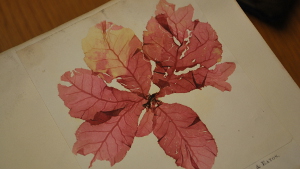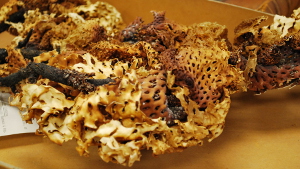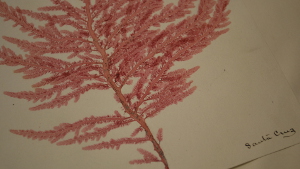"Walking down the stacks, you almost feel like you’re in Indiana Jones looking for the final resting place of the Ark of the Covenant," said Kathy Ann Miller, PhD, a curator and seaweed expert as she led me down a long, nondescript corridor flanked by row upon row of one of the greatest seaweed collections in the world.

The University Herbarium, which is tucked into the basement of the largest building on campus at UC Berkeley, just past a fearsome skeleton of a T. Rex dinosaur, is a plant museum which contains more than 200,000 specimens of seaweed, dating to the time of the U.S. Civil War. During my first visit to the museum last autumn, I was struck by Kathy Ann Miller's enthusiasm and warmth, especially when describing her herbarium "home" and its red, green and brown-hued precious occupants whom she has cherished for over 30 years.
Honestly, I hadn't given much thought to seaweed before I produced this story. But a few minutes with Kathy Ann Miller can open one's eyes to the bountiful gifts these multicellular algae bestow to their marine neighbors and terrestrial admirers. Seaweeds are like "the forest of the sea", providing habitat to fish, crabs and other marine life and their photosynthetic activity helps generate the oxygen we breathe. Also, compounds such as agar in their cell walls are used in foods such as ice cream, pharmaceuticals and cosmetics (think "age-defying" skin creams). But to really appreciate seaweeds on a level which transcends words and facts, I needed to experience seaweeds at a tactile, almost ineffable, sensory level. Happy to oblige, Miller emerged from the stacks, grinning from ear to ear with specimens of dried seaweed pressed onto paper or placed in boxes and painstakingly organized atop shelves labeled with the names of countries and regions from which they were collected decades, even a century, ago.
My image of a seaweed - uprooted, splayed, frayed and trampled upon by bare feet and salty waves - gave way to a riot of colors, textures and bizarre shapes that made me wonder at times if I was looking at a branch of stony coral or a nest stitched together by a bird taking its architectural inspiration from Cubism. Also, not all seaweeds are green, even though they all contain the green-colored chlorophyll pigment which is essential for their photosynthetic conversion of sunlight into food. That's because in the case of red and brown seaweeds, other pigments mask the coloration of the chlorophyll pigment. Even when preserved and dried for a century or more, the colors in the seaweeds can still captivate, reminiscent of stained glass illuminated by the sun's rays.

Found on all continents, seaweeds are far from endangered. Nonetheless, like other marine organisms, seaweeds are also vulnerable to acidification and warming temperatures, two major consequences of climate change. Additionally, the loss of habitat from human activity and development, and the arrival of invasive species from cargo ships crisscrossing the globe, make this a turbulent time for seaweeds near and far. "I think we’re going to find that seaweed ranges are going to change, and that southern seaweeds will be moving further north as warming happens," said Miller.

This year, with the click of a mouse and high-speed internet access, seaweed scientists around the world will be able to more quickly and methodically study the impact of climate change on large swathes of seaweeds archived at the herbarium. Funded by a grant she submitted to the National Science Foundation, in 2011, Miller and her team began taking high-resolution photographs of nearly 80,000 specimens of seaweed collected from the west coast of North America. Undergraduate work-study students have been invaluable to this project, photographing up to 400 specimens a day. With the seaweeds now digitized, Miller and her fellow curator, Andrew Doran, are completing a massive online database which features a Google map indicating the location of each specimen's collection, the date it was collected and the gorgeous photograph of the seaweed, digitally transformed into thousands of pixels. It's a captivating blend of history and modern technology, as the elegantly swooping, India-inked names of seaweed hunters come into focus beneath the translucent marine algae plucked and preserved from the wild shores of California, Oregon, Washington and points farther north many decades ago.

Reflecting on the importance of creating this digital inventory from the fragile seaweeds "sleeping in their cases", Miller told me, "without really knowing what we have in our holdings, how can we apply the lessons of the past and the hard work of all those who’ve come before us to understand what we have today and where we’re going in the future?"